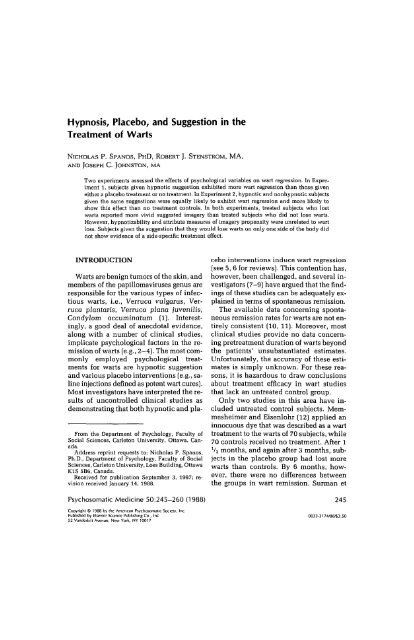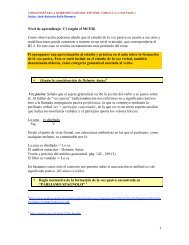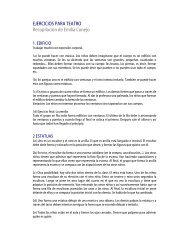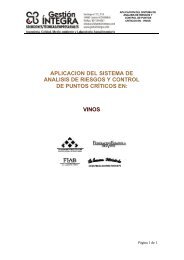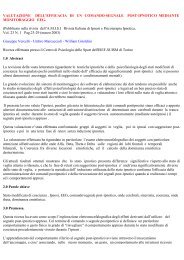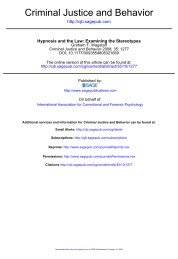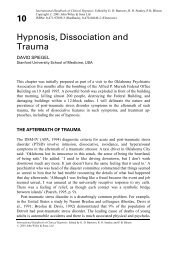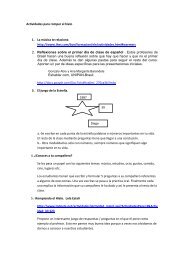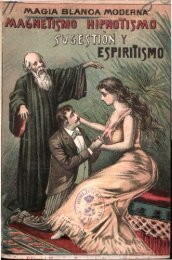Hypnosis, Placebo, and Suggestion in the Treatment of Warts
Hypnosis, Placebo, and Suggestion in the Treatment of Warts
Hypnosis, Placebo, and Suggestion in the Treatment of Warts
Create successful ePaper yourself
Turn your PDF publications into a flip-book with our unique Google optimized e-Paper software.
N. SPANOS et al.al. (13) gave hypnotic suggestions for wartremission to 17 subjects <strong>and</strong> no treatmentto seven o<strong>the</strong>rs. At <strong>the</strong> end <strong>of</strong> 3 months,53% <strong>of</strong> <strong>the</strong> hypnotic subjects, but none <strong>of</strong><strong>the</strong> controls, had lost at least some <strong>of</strong> <strong>the</strong>irwarts. The f<strong>in</strong>d<strong>in</strong>gs <strong>of</strong> <strong>the</strong>se two controlledstudies certa<strong>in</strong>ly suggest <strong>the</strong> operation <strong>of</strong>a psychological treatment effect. Never<strong>the</strong>less,given <strong>the</strong> somewhat counter<strong>in</strong>tuitivenature <strong>of</strong> <strong>the</strong> f<strong>in</strong>d<strong>in</strong>gs, <strong>the</strong> wide between-subjectvariability found <strong>in</strong> rates <strong>of</strong>spontaneous remission for warts (e.g., 11),<strong>and</strong> <strong>the</strong> small number <strong>of</strong> control subjectstested by Surman et al (13), replication <strong>of</strong><strong>the</strong>se f<strong>in</strong>d<strong>in</strong>gs is called for. The presentstudy <strong>in</strong>cludes two controlled experimentsaimed at replicat<strong>in</strong>g <strong>and</strong> extend<strong>in</strong>gprevious f<strong>in</strong>d<strong>in</strong>gs concern<strong>in</strong>g <strong>the</strong> role <strong>of</strong>psychological factors <strong>in</strong> wart remission.HYPNOSIS, IMAGERY,AND PLACEBOSOne potentially important differencebetween hypnotic <strong>and</strong> placebo treatmentsconcerns <strong>the</strong> psychological orientations thatsubjects develop toward <strong>the</strong>se procedures.Both procedures attempt to <strong>in</strong>still expectations<strong>of</strong> treatment success. However,hypnotic subjects are encouraged to see<strong>the</strong>mselves as engaged <strong>in</strong> cognitive activitythat will br<strong>in</strong>g about <strong>the</strong>ir own recovery.For example, suggestions for wartregression encourage subjects to become<strong>in</strong>volved <strong>in</strong> vividly imag<strong>in</strong><strong>in</strong>g <strong>the</strong>ir wartsas t<strong>in</strong>gl<strong>in</strong>g, shr<strong>in</strong>k<strong>in</strong>g, disappear<strong>in</strong>g, <strong>and</strong>so on. <strong>Placebo</strong> procedures, on <strong>the</strong> o<strong>the</strong>rh<strong>and</strong>, tacitly def<strong>in</strong>e subjects as <strong>the</strong> passiverecipients <strong>of</strong> a <strong>the</strong>rapeutic procedure. Subjectsgiven a placebo are not asked to imag<strong>in</strong>eanyth<strong>in</strong>g or to view <strong>the</strong>mselves as actively<strong>in</strong>volved <strong>in</strong> br<strong>in</strong>g<strong>in</strong>g about <strong>the</strong>ir ownrecovery. Instead, <strong>the</strong>y are <strong>in</strong>structed tosimply wait for <strong>the</strong>rapeutic effects to occur,or to look for <strong>in</strong>dications that sucheffects are <strong>in</strong> progress (e.g., to notice anyt<strong>in</strong>gl<strong>in</strong>g around <strong>the</strong> wart). One purpose <strong>of</strong>our first experiment was to compare wartregression <strong>in</strong> subjects assigned to a hypnotic,placebo, or no treatment controlcondition.Several <strong>in</strong>vestigators (14, 15) have arguedthat <strong>the</strong> important <strong>the</strong>rapeutic component<strong>in</strong> hypnotic treatments is <strong>the</strong> imageryencouraged by <strong>the</strong> suggestions forwart regression. Accord<strong>in</strong>g to this hypo<strong>the</strong>sis,subjects who generate <strong>the</strong> most vividsuggested imagery are <strong>the</strong> most likely toexhibit wart regression. In order to exam<strong>in</strong>ethis hypo<strong>the</strong>sis, we assessed <strong>the</strong>vividness that our hypnotic subjects attributedto <strong>the</strong>ir suggested imagery. We alsoexam<strong>in</strong>ed relationships between <strong>the</strong> report<strong>in</strong>g<strong>of</strong> suggested sensations <strong>and</strong> treatmentefficacy <strong>in</strong> both <strong>the</strong> hypnotic <strong>and</strong> placebotreatments.Hypnotizability <strong>and</strong> Wart RemissionSubjects vary substantially <strong>in</strong> <strong>the</strong>ir level<strong>of</strong> responsiveness to hypnotic suggestions(i.e., hypnotizability), <strong>and</strong> a number <strong>of</strong>st<strong>and</strong>ardized scales for <strong>the</strong> assessment <strong>of</strong>hypnotizability are available (e.g., 16).Three studies (6,17,18) reported that highlyhypnotizable subjects given a hypnotictreatment were more likely to lose wartsthan low hypnotizables. On <strong>the</strong> o<strong>the</strong>r h<strong>and</strong>,one study (9) reported that none <strong>of</strong> 20 highlyhypnotizable subjects treated with hypnosisexhibited wart regression, <strong>and</strong> ano<strong>the</strong>rstudy (13) found no relationship betweenhypnotizability <strong>and</strong> wart loss <strong>in</strong>hypnotically treated subjects.Unfortunately, most studies <strong>in</strong> this areadid not use st<strong>and</strong>ardized scales to assesshypnotizability, <strong>and</strong> <strong>the</strong> psychometric246 Psychosomatic Medic<strong>in</strong>e 50:245-260 (1988)
HYPNOSIS IN WART TREATMENTproperties <strong>of</strong> <strong>the</strong> assessment proceduresthat were used are unknown. Fur<strong>the</strong>rmore,<strong>in</strong> <strong>the</strong>se studies hypnotizability wasassessed before <strong>the</strong> hypnotic wart treatment.Consequently, subjects' knowledgethat <strong>the</strong>y were hypnotizable or unhypnotizablemay have <strong>in</strong>fluenced <strong>the</strong> manner<strong>in</strong> which <strong>the</strong>y responded to subsequentsuggestions for wart regression. For example,some evidence (19, 20) <strong>in</strong>dicatesthat hypnotizability correlates with suggestedanalgesia when hypnotizability isassessed before analgesia test<strong>in</strong>g <strong>and</strong> whensubjects conceptually l<strong>in</strong>k <strong>the</strong>ir hypnotizabilitywith <strong>the</strong> analgesia test situation.However, when hypnotiability is assessedafter analgesia test<strong>in</strong>g,or if low hypnotizablesare assured that <strong>the</strong>y can exhibit suggestedanalgesia despite <strong>the</strong>ir low hypnotizability,<strong>the</strong>n <strong>the</strong> significant correlationbetween hypnotizability <strong>and</strong> suggestedanalgesia <strong>of</strong>ten disappears. In o<strong>the</strong>r words,hypnotizability test<strong>in</strong>g can create potentexpectations concern<strong>in</strong>g how subjects arelikely to respond to forthcom<strong>in</strong>g suggestions.For example, as a consequence <strong>of</strong>hav<strong>in</strong>g previously tested low <strong>in</strong> hypnotizability,some subjects may come to believethat <strong>the</strong>y are unable to generate <strong>the</strong> imagerycalled for by <strong>the</strong> suggestion for wartremission. Therefore <strong>the</strong>se subjects maymake no attempt, or only a half-heartedattempt, to generate such imagery. In <strong>the</strong>present experiments we elim<strong>in</strong>ated potential<strong>in</strong>terpretive problems <strong>of</strong> this k<strong>in</strong>d byassess<strong>in</strong>g hypnotizability at <strong>the</strong> end <strong>of</strong> <strong>the</strong>6-week assessment period that followedtreatment adm<strong>in</strong>istration.Some <strong>in</strong>vestigators (21) have suggestedthat hypnotizability should predict wartregression follow<strong>in</strong>g psychological <strong>in</strong>terventionregardless <strong>of</strong> whe<strong>the</strong>r <strong>the</strong> psychologicaltreatment <strong>in</strong>volves adm<strong>in</strong>istration<strong>of</strong> an hypnotic <strong>in</strong>duction procedure. Totest this possibility we assessed subjects<strong>in</strong> all treatments for hypnotizability at <strong>the</strong>end <strong>of</strong> <strong>the</strong>ir follow-up period.Specificity EffectsPerhaps <strong>the</strong> most dramatic f<strong>in</strong>d<strong>in</strong>g <strong>in</strong>this research area concerns <strong>the</strong> idea thatsuggestions can exert a selective effect onwart regression. In one study (18), highlyhypnotizable subjects, all <strong>of</strong> whom hadwarts on both sides <strong>of</strong> <strong>the</strong>ir body, weregiven <strong>the</strong> hypnotic suggestion that <strong>the</strong>ywould lose only <strong>the</strong> warts on one side. Thesuggestion was always aimed toward <strong>the</strong>side <strong>of</strong> <strong>the</strong> body with <strong>the</strong> largest number<strong>of</strong> warts. N<strong>in</strong>e out <strong>of</strong> <strong>the</strong> ten highly hypnotizablesubjects lost warts only on <strong>the</strong>treated side, while <strong>the</strong> rema<strong>in</strong><strong>in</strong>g subjectlost warts bilaterally.Five subsequent studies (7-9, 13, 22)have reported failures to replicate this sidespecific treatment effect. However, most <strong>of</strong><strong>the</strong>se replication failures have had methodologicaldifficulties. For <strong>in</strong>stance, <strong>in</strong> two<strong>of</strong> <strong>the</strong>se studies (9, 22), so few subjects lostwarts on ei<strong>the</strong>r side that no conclusionsabout a side-specific effect were possible.Two o<strong>the</strong>r studies (7, 8) failed to f<strong>in</strong>d aside-specific effect when us<strong>in</strong>g a placeboas <strong>the</strong> treatment. Unfortunately, nei<strong>the</strong>rstudy employed hypnotic suggestion.Surman et al. (13) unambiguously failedto replicate <strong>the</strong> side-specific treatment effect.In that study, ten subjects with bilateralwarts lost warts follow<strong>in</strong>g a hypnoticsuggestion directed at one side <strong>of</strong> <strong>the</strong> body.In n<strong>in</strong>e out <strong>of</strong> <strong>the</strong> ten cases, however, wartloss was bilateral ra<strong>the</strong>r than treatmentsidespecific.In order to fur<strong>the</strong>r explore <strong>the</strong> side-specificeffect, subjects <strong>in</strong> both <strong>of</strong> our experimentswith bilateral warts were given atreatment directed to only one side <strong>of</strong> <strong>the</strong>irPsychosomatic Medic<strong>in</strong>e 50:245-260 (1988) 247
N. SPANOSetal.body. To test for <strong>the</strong> specificity effect, <strong>the</strong>data from <strong>the</strong> two experiments were comb<strong>in</strong>ed.Consequently, <strong>the</strong>se f<strong>in</strong>d<strong>in</strong>gs arediscussed at <strong>the</strong> end <strong>of</strong> Experiment 2.METHOD (EXPERIMENT 1)SubjectsSixty-four <strong>in</strong>dividuals with warts on one or bothh<strong>and</strong>s (29 males, 35 females, ages 10-74 years) weresolicited for participation <strong>in</strong> a study <strong>of</strong> warts throughadvertisements placed on posters around <strong>the</strong> CarletonUniversity campus, <strong>in</strong> local newspapers, <strong>and</strong> on<strong>the</strong> radio. Subjects were <strong>in</strong>formed that several treatmentsfor warts were be<strong>in</strong>g compared <strong>and</strong> that somesubjects would be assigned to a placebo treatment.Subjects were asked to absta<strong>in</strong> from any o<strong>the</strong>r warttreatment for <strong>the</strong> duration <strong>of</strong> <strong>the</strong> study. All were paid$15 for <strong>the</strong>ir participation.ProcedureSubjects were r<strong>and</strong>omly assigned to a hypnoticsuggestion (N = 22), cold laser placebo (N = 24), orno treatment control condition (N = 17). All subjectswere seen <strong>in</strong>dividually by a research assistant, whocounted <strong>the</strong> warts on each <strong>of</strong> <strong>the</strong>ir h<strong>and</strong>s <strong>and</strong> recorded<strong>the</strong>ir age <strong>and</strong> <strong>the</strong>ir estimates <strong>of</strong> <strong>the</strong> duration<strong>of</strong> <strong>the</strong>ir warts (<strong>in</strong> months). Subjects were <strong>the</strong>n escortedto <strong>the</strong> treatment room <strong>and</strong> <strong>in</strong>troduced to <strong>the</strong>male <strong>the</strong>rapist, who conducted both <strong>the</strong> hypnotic<strong>and</strong> placebo treatments. Hypnotic <strong>and</strong> placebo subjectswere adm<strong>in</strong>istered <strong>the</strong>ir respective treatments<strong>and</strong> scheduled to return <strong>in</strong> six weeks for follow-upevaluation. Control subjects were <strong>in</strong>formed that <strong>the</strong>ywere on a wait<strong>in</strong>g list <strong>and</strong> were asked to return <strong>in</strong> 6weeks to receive treatment. At <strong>the</strong> 6 weeks followupsession, subjects aga<strong>in</strong> had <strong>the</strong>ir warts countedby a research assistant <strong>and</strong> were <strong>the</strong>n tested for hypnotizabilityus<strong>in</strong>g <strong>the</strong> Carleton University Responsivenessto <strong>Suggestion</strong> Scale (CURSS; 13). This scaleyields an objective (CURSS: 0) score that reflects <strong>the</strong>number <strong>of</strong> suggestions to which subjects made <strong>the</strong>appropriate behavioral response, <strong>and</strong> a subjective score(CURSS: S) that reflects <strong>the</strong> <strong>in</strong>tensity <strong>of</strong> <strong>the</strong>ir subjectiveresponses to <strong>the</strong> suggestions. At this time, subjectswere also assessed on a modification <strong>of</strong> <strong>the</strong> Bettsvividness <strong>of</strong> imagery questionnaire (23). The researchassistant who counted subjects' warts <strong>in</strong> <strong>the</strong> basel<strong>in</strong>e<strong>and</strong> follow-up sessions was bl<strong>in</strong>d to subjects' treatmentassignment.Hypnotic <strong>Treatment</strong>.Eleven <strong>of</strong> <strong>the</strong> 22 subjects <strong>in</strong> this group had wartson both h<strong>and</strong>s. In <strong>the</strong>se 11 cases, one h<strong>and</strong> was chosenat r<strong>and</strong>om as <strong>the</strong> target h<strong>and</strong>, <strong>and</strong> all treatmentsuggestions were referred exclusively to <strong>the</strong> targeth<strong>and</strong>. After be<strong>in</strong>g comfortably seated <strong>and</strong> asked toclose <strong>the</strong>ir eyes, subjects were orally adm<strong>in</strong>istered a5-m<strong>in</strong> hypnotic <strong>in</strong>duction procedure (modified from24). Follow<strong>in</strong>g <strong>the</strong> <strong>in</strong>duction procedure, <strong>and</strong> withouta break <strong>in</strong> cont<strong>in</strong>uity, subjects were adm<strong>in</strong>istered asuggestion for wart elim<strong>in</strong>ation that was 2 m<strong>in</strong> <strong>in</strong>duration. The suggestion asked subjects to attend to<strong>the</strong> sensations <strong>in</strong> <strong>the</strong>ir target h<strong>and</strong> <strong>and</strong> <strong>in</strong>formed <strong>the</strong>mrepeatedly that <strong>the</strong> sk<strong>in</strong> around <strong>the</strong>ir warts was beg<strong>in</strong>n<strong>in</strong>gto t<strong>in</strong>gle <strong>and</strong> grow warm. The suggestion also<strong>in</strong>formed subjects that <strong>the</strong>ir warts would shr<strong>in</strong>k <strong>and</strong>fall <strong>of</strong>f <strong>and</strong> asked <strong>the</strong>m to vividly imag<strong>in</strong>e <strong>the</strong>ir wartsshr<strong>in</strong>k<strong>in</strong>g <strong>in</strong> size <strong>and</strong> dissolv<strong>in</strong>g away. Follow<strong>in</strong>g <strong>the</strong>suggestion, subjects opened <strong>the</strong>ir eyes <strong>and</strong> rated <strong>the</strong>vividness with which <strong>the</strong>y had imag<strong>in</strong>ed <strong>the</strong>ir wartsshr<strong>in</strong>k<strong>in</strong>g <strong>and</strong> disappear<strong>in</strong>g on a 7-po<strong>in</strong>t scale withalternatives that ranged from "No image present"(scored 0) to "Extremely vivid; as vivid as though itwas actually happen<strong>in</strong>g" (scored 6). Next, subjectsrated <strong>the</strong> <strong>in</strong>tensity with which <strong>the</strong>y experienced sixsensations around <strong>the</strong>ir warts (t<strong>in</strong>gl<strong>in</strong>g, warmth,throbb<strong>in</strong>g, numbness, shr<strong>in</strong>k<strong>in</strong>g, prickl<strong>in</strong>g). Eachsensation was rated on a 7-po<strong>in</strong>t scale that rangedfrom "not at all" (scored 0) to "strongly" (scored 6).The six items were totaled to yield a s<strong>in</strong>gle sensationscore for each subject.Follow<strong>in</strong>g <strong>the</strong>ir sensation rat<strong>in</strong>gs, subjects wereasked to aga<strong>in</strong> close <strong>the</strong>ir eyes <strong>and</strong> were readm<strong>in</strong>istered<strong>the</strong> same 2-m<strong>in</strong> suggestion. F<strong>in</strong>ally, subjectswere "awakened," <strong>in</strong>structed to count <strong>the</strong>ir warts everyday, <strong>and</strong> after each count<strong>in</strong>g to close <strong>the</strong>ir eyes <strong>and</strong>spend 3 to 4 m<strong>in</strong> imag<strong>in</strong><strong>in</strong>g <strong>the</strong> warts on <strong>the</strong>ir targeth<strong>and</strong> disappear<strong>in</strong>g.<strong>Placebo</strong> <strong>Treatment</strong>These subjects were <strong>in</strong>formed that <strong>the</strong>y would betreated with a relatively new technique known as a"cold laser." They were given a few m<strong>in</strong>utes to readan article from Life Magaz<strong>in</strong>e (May 1982) on <strong>the</strong> medicaluse <strong>of</strong> lasers, <strong>and</strong> afterwards <strong>the</strong>y read a briefbut technical account <strong>of</strong> laser action. This technicalaccount <strong>in</strong>cluded an explanation <strong>in</strong> terms <strong>of</strong> "differentialtissue density" <strong>of</strong> how <strong>the</strong> cold laser wouldkill <strong>the</strong>ir warts without effect<strong>in</strong>g surround<strong>in</strong>g healthytissue. Subjects with bilateral warts (N = 12) were<strong>in</strong>formed that only one h<strong>and</strong> would be treated at that248 Psychosomatic Medic<strong>in</strong>e 50:245-260 (1988)
HYPNOSIS IN WART TREATMENTtime <strong>and</strong> that <strong>the</strong> o<strong>the</strong>r h<strong>and</strong> would be treated <strong>in</strong> 6weeks. The target h<strong>and</strong> was chosen r<strong>and</strong>omly.The "laser" was housed <strong>in</strong> a sound-attenuatedchamber. It was a metal devise with numerous dials<strong>and</strong> buttons <strong>and</strong> an open<strong>in</strong>g <strong>in</strong> which subjects placed<strong>the</strong>ir target h<strong>and</strong>. When <strong>the</strong> "laser" was switched on,it made a whirr<strong>in</strong>g sound, <strong>and</strong> a sweep<strong>in</strong>g p<strong>in</strong>k lightcould be seen <strong>in</strong> <strong>the</strong> open<strong>in</strong>g. Subjects donned "protectivegoggles" <strong>and</strong> placed <strong>the</strong>ir h<strong>and</strong> <strong>in</strong> <strong>the</strong> open<strong>in</strong>gfor <strong>the</strong> first <strong>of</strong> two 4-m<strong>in</strong> "laser doses." They weretold that <strong>the</strong>y might experience some t<strong>in</strong>gl<strong>in</strong>g, prickl<strong>in</strong>g,<strong>and</strong> warmth <strong>in</strong> <strong>the</strong>ir h<strong>and</strong> dur<strong>in</strong>g <strong>the</strong> treatmentbut not to be alarmed at <strong>the</strong>se sensations. Follow<strong>in</strong>gthat first "laser dose," subjects completed <strong>the</strong> samesensation questionnaire given to <strong>the</strong> hypnotic subjects,<strong>and</strong> <strong>the</strong>n placed <strong>the</strong>ir h<strong>and</strong> back <strong>in</strong> <strong>the</strong> "laser"for <strong>the</strong>ir second dose. Follow<strong>in</strong>g <strong>the</strong> placebo treatment,subjects were <strong>in</strong>structed to count <strong>the</strong>ir wartsevery day <strong>and</strong> at <strong>the</strong>se times to notice whe<strong>the</strong>r <strong>the</strong>yexperienced any sensations <strong>in</strong> <strong>the</strong>ir warts.No <strong>Treatment</strong> ControlsAfter <strong>the</strong>ir warts were counted, <strong>the</strong>se subjects were<strong>in</strong>formed that <strong>the</strong>y were on a wait<strong>in</strong>g list <strong>and</strong> wouldbe adm<strong>in</strong>istered a treatment for <strong>the</strong>ir warts <strong>in</strong> 6 week'stime.RESULTSTable 1 shows <strong>the</strong> number <strong>of</strong> warts atbasel<strong>in</strong>e for subjects <strong>in</strong> <strong>the</strong> three conditions.A one way analysis <strong>of</strong> variance {AN-OVA) <strong>in</strong>dicated no significant differencesamong conditions <strong>in</strong> number <strong>of</strong> basel<strong>in</strong>ewarts, F(2,61) < 1. Separate ANOVAs also<strong>in</strong>dicated no significant differences betweenconditions <strong>in</strong> subjects' ages or <strong>in</strong><strong>the</strong>ir estimates <strong>of</strong> wart duration.Unfortunately, <strong>the</strong>re is no ideal way toquantify wart loss. In <strong>the</strong> present study <strong>the</strong>number <strong>of</strong> warts possessed by subjects atbasel<strong>in</strong>e ranged from one to 60. Almost athird <strong>of</strong> <strong>the</strong> subjects (N = 20) had onlyone wart at basel<strong>in</strong>e, <strong>and</strong> slightly more thanhalf <strong>the</strong> subjects (N = 33) had three or fewerwarts at basel<strong>in</strong>e. Subjects with a smallnumber <strong>of</strong> basel<strong>in</strong>e warts could show onlysmall decreases <strong>in</strong> absolute number <strong>of</strong>warts, even when <strong>the</strong>y lost all <strong>of</strong> <strong>the</strong>ir warts.On <strong>the</strong> o<strong>the</strong>r h<strong>and</strong>, a measure <strong>of</strong> percentageloss also has difficulties. For example,a subject who loses her only wart gets ahigher percentage loss score (100%) thana subject who loses 25 <strong>of</strong> his 50 warts (50%).We dealt with <strong>the</strong> measurement issue byus<strong>in</strong>g both a cont<strong>in</strong>uous <strong>and</strong> a dichotomous<strong>in</strong>dex <strong>of</strong> wart loss. The cont<strong>in</strong>uous<strong>in</strong>dex was percentage <strong>of</strong> wart loss frombasel<strong>in</strong>e, <strong>and</strong> <strong>the</strong> dichotomous <strong>in</strong>dex waswhe<strong>the</strong>r or not a subject lost any (one ormore) warts.<strong>Treatment</strong> EffectsTable 1 shows that subjects <strong>in</strong> <strong>the</strong> threeconditions differed significantly <strong>in</strong> percentage<strong>of</strong> warts lost (F (2,61) = 7.17,p < 0.01). Post hoc analyses <strong>in</strong>dicated thatTABLE 1. Means for Number <strong>of</strong> <strong>Warts</strong> at Basel<strong>in</strong>e, Percent Wart Loss, Age <strong>and</strong> Estimated Duration <strong>of</strong><strong>Warts</strong> <strong>in</strong> Hypnotic, <strong>Placebo</strong>, <strong>and</strong> No <strong>Treatment</strong> Control ConditionsBasel<strong>in</strong>ePercent lossAgeDuration<strong>Hypnosis</strong>MSD7.32"14.9233.68 a 41.4829.45 a11.1377.83 a 97.31<strong>Placebo</strong>MSD7.21 a10.769.08 6 22.2528.33 a13.4064.04 a 43.70With<strong>in</strong> rows, means shar<strong>in</strong>g <strong>the</strong> same letter superscript fail to differ significantly at a = .05.Estimated duration is <strong>in</strong> months.ControlMSD5.35 a6.112.06 b6.3929.06 a14.0478.00 a 52.95Psychosomatic Medic<strong>in</strong>e 50:245-260 (1988) 249
N. SPANOS et al.TABLE 2. Number <strong>of</strong> Subjects Who LostOne or More <strong>Warts</strong> or Who Did Not LoseAny <strong>Warts</strong> <strong>in</strong> <strong>Hypnosis</strong>, <strong>Placebo</strong>, <strong>and</strong> No<strong>Treatment</strong> Control ConditionLostDid not lose<strong>Hypnosis</strong> <strong>Placebo</strong> Controlhypnotic subjects lost a greater percentage<strong>of</strong> warts than subjects <strong>in</strong> ei<strong>the</strong>r <strong>the</strong> placeboor control group. The latter two groupsfailed to differ significantly <strong>in</strong> this regard.Table 2 shows <strong>the</strong> number <strong>of</strong> subjects<strong>in</strong> each condition who lost at least onewart <strong>and</strong> <strong>the</strong> number who lost no warts.The three conditions differed significantly<strong>in</strong> this respect, (X 2 (2) = 7.35, p < 0.05).Fur<strong>the</strong>r analysis <strong>in</strong>dicated that significantlymore hypnotic subjects than controlslost warts (X 2 (lj = 6.45, p < 0.01).Hypnotic subjects were also marg<strong>in</strong>allymore likely than placebo subjects to losewarts, (X 2 (l) = 3.43, p = 0.06). However,placebo <strong>and</strong> control subjects failed to differ<strong>in</strong> this regard, (X 2 (1) = 0.98).Recall that subjects <strong>in</strong> both <strong>the</strong> hypnotic<strong>and</strong> placebo conditions rated <strong>the</strong> vividnesswith which <strong>the</strong>y imag<strong>in</strong>ed <strong>the</strong> sensationssuggested to <strong>the</strong>m. Hypnotic subjects[M = 20.86; SD = 13.00) rated <strong>the</strong>irsuggested sensations as significantly morevivid than did placebo subjects (M = 6.42,SD = 7.01, t [44] = 4.75, p < 0.01).<strong>Warts</strong> at Basel<strong>in</strong>eSubjects <strong>in</strong> both <strong>the</strong> hypnotic <strong>and</strong> placeboconditions were divided <strong>in</strong>to thosewho lost warts <strong>and</strong> those who did not. Theresultant four groups were compared onnumber <strong>of</strong> warts at basel<strong>in</strong>e with a 2 x 2hypnosis/placebo x lost/did not lose between-subjectsANOVA. Subjects who lostwarts (M = 12.94, SD = 18.27) had significantlymore warts at basel<strong>in</strong>e than thosewho did not lose warts [M = 3.97,SD = 3.90, F [1.42] = 6.66, p < 0.01). Noo<strong>the</strong>r effects achieved significance.Table 3 shows <strong>the</strong> number <strong>of</strong> hypnotic<strong>and</strong> placebo subjects who had ei<strong>the</strong>r onewart at basel<strong>in</strong>e or more than one wart atbasel<strong>in</strong>e. In both conditions, subjects wholost warts tended to have multiple wartsra<strong>the</strong>r than a s<strong>in</strong>gle wart at basel<strong>in</strong>e. When<strong>the</strong> conditions were comb<strong>in</strong>ed, subjectswho lost warts were significantly morelikely than those who did not to have multiplewarts at basel<strong>in</strong>e (X 2 (1) = 4.98,P < 0.05).Gender EffectsTo exam<strong>in</strong>e gender effects, subjects <strong>in</strong><strong>the</strong> hypnotic <strong>and</strong> placebo groups were aga<strong>in</strong>comb<strong>in</strong>ed. Males <strong>in</strong> <strong>the</strong> comb<strong>in</strong>ed treatment(M = 6.68, SD = 11.02) did not differ<strong>in</strong> number <strong>of</strong> basel<strong>in</strong>e warts from females(M = 7.75, SD = 13.32).Never<strong>the</strong>less, females <strong>in</strong> <strong>the</strong> comb<strong>in</strong>edtreatments (M = 34.21, SD = 41.70) losta significantly greater percentage <strong>of</strong> <strong>the</strong>irwarts than did males (M = 6.27,SD = 16.19, F [1,44] = 8.86, p < 0.01).Table 4 shows that females <strong>in</strong> <strong>the</strong> com-TABLC 3. Number <strong>of</strong> Subjects with OneBasel<strong>in</strong>e Wart or Multiple Basel<strong>in</strong>e <strong>Warts</strong>Who Lost or Did Not Lose <strong>Warts</strong> <strong>in</strong> <strong>the</strong><strong>Hypnosis</strong> <strong>and</strong> <strong>Placebo</strong> Conditions1 Basel<strong>in</strong>e wart 1 Basel<strong>in</strong>e wart<strong>Hypnosis</strong>LostDid not lose<strong>Placebo</strong>LostDid not loseComb<strong>in</strong>edLostDid not lose2607213956111516250 Psychosomatic Medic<strong>in</strong>e 50:245-260 (1988)
HYPNOSIS IN WART TREATMENTTABLE 4. Number <strong>of</strong> Males <strong>and</strong> Females Los<strong>in</strong>g<strong>and</strong> Not Los<strong>in</strong>g <strong>Warts</strong> <strong>in</strong> <strong>the</strong> <strong>Hypnosis</strong> <strong>and</strong><strong>Placebo</strong> Conditions Comb<strong>in</strong>edLostDid not loseMalesFemalesb<strong>in</strong>ed treatments more frequently lost atleast one wart than did males, X 2 (1) = 6.88,p
N. SPANOSetal.lost fewer warts than hypnotic subjects <strong>and</strong>also reported less <strong>in</strong>tense experienc<strong>in</strong>g <strong>of</strong>suggested sensations than did hypnoticsubjects. These f<strong>in</strong>d<strong>in</strong>gs may <strong>in</strong>dicate thathypnotic subjects were more subjectively<strong>in</strong>volved <strong>in</strong> <strong>the</strong>ir treatment than were placebosubjects <strong>and</strong> that subjective <strong>in</strong>volvement<strong>in</strong> <strong>the</strong> treatment process is helpful<strong>in</strong> br<strong>in</strong>g<strong>in</strong>g about wart regression. Thef<strong>in</strong>d<strong>in</strong>g that placebo group subjects failedto differ significantly from controls <strong>in</strong> wartloss was somewhat surpris<strong>in</strong>g given <strong>the</strong>significant placebo effect reported byMemmesheimer <strong>and</strong> Eisenlohr (12). Perhapsour ra<strong>the</strong>r complicated "cold laser"placebo was simply less conv<strong>in</strong>c<strong>in</strong>g thansuch relatively simple procedures as hav<strong>in</strong>gmedical personnel (<strong>in</strong>stead <strong>of</strong> psychologists)pa<strong>in</strong>t <strong>the</strong> warts or <strong>in</strong>ject subjectswith <strong>in</strong>nocuous substances def<strong>in</strong>edas powerful wart medications. Futurestudies that employ a range <strong>of</strong> differentplacebo procedures, <strong>and</strong> that <strong>in</strong>dependentlyassess each procedure for believability,might provide useful <strong>in</strong>formation.In hypnotic subjects, wart regressioncorrelated significantly with <strong>the</strong> reportedvividness <strong>of</strong> suggested imagery <strong>and</strong> suggestedsensations. Interest<strong>in</strong>gly, <strong>in</strong> <strong>the</strong>sesame subjects wart regression failed to correlatesignificantly with ei<strong>the</strong>r an attributemeasure <strong>of</strong> <strong>the</strong> propensity to imag<strong>in</strong>e vividly(The Betts Questionnaire) or withhypnotizability dimension. These f<strong>in</strong>d<strong>in</strong>gs<strong>in</strong>dicate that <strong>in</strong> <strong>the</strong> case <strong>of</strong> wartregression, situation specific <strong>in</strong>dicators <strong>of</strong>subjects' cognitive <strong>in</strong>volvements <strong>and</strong> motivationsmay be better outcome predictorsthan global <strong>in</strong>dexes <strong>of</strong> fantasy proneness<strong>and</strong> suggestibility. The global <strong>in</strong>dicatorsmay simply be too far removed from <strong>the</strong>particular constellation <strong>of</strong> context specificmotivations, imag<strong>in</strong><strong>in</strong>gs, <strong>and</strong> beliefs thatdeterm<strong>in</strong>e subjects' responses to <strong>the</strong> treatmentsuggestions. On <strong>the</strong> o<strong>the</strong>r h<strong>and</strong>, <strong>the</strong>sef<strong>in</strong>d<strong>in</strong>gs may simply po<strong>in</strong>t to limitations<strong>in</strong> <strong>the</strong> particular <strong>in</strong>dexes <strong>of</strong> imagery <strong>and</strong>hypnotizability employed <strong>in</strong> our study. Toexam<strong>in</strong>e this possibility, our second experimentemployed a second st<strong>and</strong>ardizedtest <strong>of</strong> hypnotizability <strong>and</strong> two differentattribute measures <strong>of</strong> imag<strong>in</strong>al activity.Our f<strong>in</strong>d<strong>in</strong>g that treatment effects werelarger for females than for males was surpris<strong>in</strong>g,because five previous studies (6,12, 13, 17, 22) found no sex differences <strong>in</strong>wart regression <strong>in</strong> subjects treated wi<strong>the</strong>i<strong>the</strong>r hypnotic suggestion or placebo.Thus, our f<strong>in</strong>d<strong>in</strong>gs with respect to sex differencesshould be considered highly tentativeuntil replicated.Our f<strong>in</strong>d<strong>in</strong>g that subjects with manywarts showed a better treatment responsethan those with only a few is consistentwith <strong>the</strong> results <strong>of</strong> at least two earlier studies(12, 22). In one study (22), for example,30% <strong>of</strong> <strong>the</strong> 10 subjects with four or morewarts showed wart regression follow<strong>in</strong>ghypnotic treatment, while none <strong>of</strong> <strong>the</strong> 12subjects with three or fewer warts showedany treatment effect.EXPERIMENT 2A good deal <strong>of</strong> experimental work <strong>in</strong>dicatesthat hypnotic <strong>and</strong> motivated nonhypnoticsubjects respond equivalentlywhen given <strong>the</strong> same suggestions. Equivalentlevels <strong>of</strong> respond<strong>in</strong>g <strong>in</strong> <strong>the</strong>se twogroups have been found for suggestionsthat call for such varied responses as analgesia,age-regression, halluc<strong>in</strong>ation, motoric<strong>and</strong> sensory alterations, <strong>and</strong> allergicreactions (for reviews, see 25, 26). Onlyone study (22) compared hypnotic <strong>and</strong>nonhypnotic subjects given <strong>the</strong> same suggestionfor wart regression. Unfortunately,<strong>the</strong> number <strong>of</strong> subjects per treatment wassmall, a no-treatment control condition was252 Psychosomatic Medic<strong>in</strong>e 50:245-260 (1988)
HYPNOSIS IN WART TREATMENTnot employed, <strong>and</strong> very few subjects <strong>in</strong>ei<strong>the</strong>r treatment lost warts. Consequently,<strong>the</strong> results were ambiguous.The major components <strong>in</strong> hypnotictreatments for wart regression usually <strong>in</strong>clude<strong>the</strong> def<strong>in</strong>ition <strong>of</strong> <strong>the</strong> situation ashypnosis, <strong>the</strong> adm<strong>in</strong>istration <strong>of</strong> an <strong>in</strong>ductionprocedure that emphasises relaxation,<strong>and</strong> suggestions to imag<strong>in</strong>e <strong>the</strong> warts disappear<strong>in</strong>g.In order to determ<strong>in</strong>e whe<strong>the</strong>rdef<strong>in</strong><strong>in</strong>g <strong>the</strong> situation as hypnosis or relaxationfacilitated any wart regression effectsproduced by <strong>the</strong> suggestion alone, wecompared <strong>the</strong> follow<strong>in</strong>g four conditions;a) hypnotic <strong>in</strong>duction plus suggestion, b)<strong>the</strong> same suggestion preceeded by nonhypnoticrelaxation <strong>in</strong>structions, c) <strong>the</strong>suggestion alone, <strong>and</strong> d) a no-treatmentcontrol condition. Each subject was adm<strong>in</strong>istered<strong>the</strong>ir treatment twice separatedby a 1-week <strong>in</strong>terval. Follow<strong>in</strong>g each treatmentsession, subjects rated <strong>the</strong> vividnesswith which <strong>the</strong>y imag<strong>in</strong>ed <strong>the</strong> sensationssuggested to <strong>the</strong>m <strong>the</strong>ir degree <strong>of</strong> relaxation,<strong>and</strong> <strong>the</strong> extent to which <strong>the</strong>y experiencedgeneralized alterations <strong>in</strong> consciousness(e.g., "I felt dazed," "time stoodstill"). A number <strong>of</strong> <strong>in</strong>vestigators (e.g., 27)have emphasized <strong>the</strong> importance <strong>of</strong> subjects'expectations <strong>of</strong> treatment success <strong>in</strong>br<strong>in</strong>g<strong>in</strong>g about wart regression. In fact, ithas been argued (27) that expectation is<strong>the</strong> only important psychological mediator<strong>of</strong> wart regression. Supposedly, o<strong>the</strong>rpsychological variables (such as engag<strong>in</strong>g<strong>in</strong> <strong>the</strong> suggested imagery) are importantonly to <strong>the</strong> extent that <strong>the</strong>y bolster subjects'expectations <strong>of</strong> treatment success.Alternatively, o<strong>the</strong>r <strong>in</strong>vestigators havesuggested that subjects' expectations arelargely unrelated to treatment outcome <strong>and</strong>have reported successful treatment <strong>in</strong>highly skeptical subjects (e.g., 28, 29). Unfortunately,no studies have systematicallyassessed <strong>the</strong> relationship betweenexpectations <strong>and</strong> treatment outcome. Inorder to exam<strong>in</strong>e this issue, subjects <strong>in</strong> each<strong>of</strong> our treatments estimated how effective<strong>the</strong>y believed <strong>the</strong>ir treatment would be atremov<strong>in</strong>g <strong>the</strong>ir warts.At <strong>the</strong> end <strong>of</strong> <strong>the</strong> 6-week follow-up period,all subjects were tested on two differenthypnotizability scales <strong>and</strong> were adm<strong>in</strong>isteredTellegen <strong>and</strong> Atk<strong>in</strong>son's (30)questionnaire measure <strong>of</strong> absorption <strong>in</strong>imag<strong>in</strong>ative activities, as well as <strong>the</strong> version<strong>of</strong> <strong>the</strong> Betts' imagery questionnaireused <strong>in</strong> Experiment 1 (23).METHODSubjectsForty-five males <strong>and</strong> 31 females (ages 15-66 years)with warts on one or both h<strong>and</strong>s were recruited forparticipation <strong>in</strong> a study on <strong>the</strong> psychological treatment<strong>of</strong> warts <strong>in</strong> <strong>the</strong> same manner as <strong>in</strong> Experiment1.ProcedureSubjects were r<strong>and</strong>omly assigned to four conditionswith 19 subjects <strong>in</strong> each condition. The fourconditions were a) <strong>the</strong> same hypnotic <strong>in</strong>duction procedureplus wart remission suggestion used <strong>in</strong> Experiment1, b) <strong>the</strong> wart remission suggestion preceededby relaxation <strong>in</strong>structions <strong>in</strong> place <strong>of</strong> <strong>the</strong>hypnotic <strong>in</strong>duction, c) <strong>the</strong> suggestion alone withoutprelim<strong>in</strong>ary hypnotic or relaxation <strong>in</strong>structions, <strong>and</strong>d) no treatment control.The relaxation <strong>in</strong>structions were modelled after<strong>the</strong> hypnotic <strong>in</strong>structions used <strong>in</strong> Experiment 1. Theywere <strong>the</strong> same length as <strong>the</strong> hypnotic <strong>in</strong>structions.However, <strong>the</strong>y def<strong>in</strong>ed <strong>the</strong> situation as relaxationra<strong>the</strong>r than hypnosis, <strong>and</strong> all references to drows<strong>in</strong>ess,sleep, <strong>and</strong> hypnosis were replaced with referencesto relaxation <strong>and</strong> comfort.Subjects <strong>in</strong> <strong>the</strong> three treatment groups were adm<strong>in</strong>istered<strong>the</strong>ir respective treatment procedurestwice, with a week separat<strong>in</strong>g <strong>the</strong> two adm<strong>in</strong>istrations.With<strong>in</strong> each treatment, 11 subjects were adm<strong>in</strong>istered<strong>the</strong> procedures by a male experimenter,<strong>and</strong> eight were adm<strong>in</strong>istered <strong>the</strong>m by a female experimenter.Subjects <strong>in</strong> all conditions returned forfollow-up evaluation 6 weeks after <strong>the</strong>ir <strong>in</strong>itial ses-Psychosomatic Medic<strong>in</strong>e 50:245-260 (1988) 253
N. SPANOS et al.sion. In <strong>the</strong> first session, <strong>and</strong> aga<strong>in</strong> at <strong>the</strong> 6-weekfollow-up, subjects' warts were counted by a technicianwho was bl<strong>in</strong>d to subjects' treatment assignment.In-session QuestionnairesImmediately after each treatment procedure, subjectswere adm<strong>in</strong>istered <strong>the</strong> follow<strong>in</strong>g questionnaires.Intensity <strong>of</strong> Imag<strong>in</strong>ed Sensations. Subjects rated<strong>the</strong> extent to which <strong>the</strong>y experienced each <strong>of</strong> <strong>the</strong> foursensations (i.e., t<strong>in</strong>gl<strong>in</strong>g, warmth, shr<strong>in</strong>k<strong>in</strong>g, prickl<strong>in</strong>g)described <strong>in</strong> <strong>the</strong> suggestion. Each sensation wasrated on a 7-po<strong>in</strong>t scale, <strong>and</strong> <strong>the</strong> four sensation itemswere totaled to yield a s<strong>in</strong>gle suggested vividnessscore.Expectation <strong>of</strong> <strong>Treatment</strong> Success. Subjects respondedto <strong>the</strong> follow<strong>in</strong>g item: "How effective do youth<strong>in</strong>k this treatment will be at remov<strong>in</strong>g your warts?"Alternatives ranged from "not at all effective" (scored0) through "moderately effective" (scored 5) to "extremelyeffective" (scored 10).Altered Experience. Field (31) constructed a scaleto assess alterations <strong>in</strong> experience frequently associatedwith hypnotic <strong>in</strong>duction (e.g., "I felt dazed").We modified <strong>the</strong> scale by elim<strong>in</strong>at<strong>in</strong>g all items thatmade explicit reference to sleep or hypnosis. Thirtythreeitems rema<strong>in</strong>ed that tapped a range <strong>of</strong> alterations<strong>in</strong> body image, relaxation, <strong>and</strong> sensory experiences.All items were scored dichotomously <strong>and</strong>totaled to yield a s<strong>in</strong>gle altered experience score.Relaxation. Subjects rated <strong>the</strong>ir degree <strong>of</strong> relaxationon a six-item scale that was anchored with <strong>the</strong>descriptors "very tense" (scored 1) at one end to "veryrelaxed" (scored 6) at <strong>the</strong> o<strong>the</strong>r end.Measures Taken at Follow-upAfter <strong>the</strong>ir warts had been counted at <strong>the</strong> 6-weekfollow-up, subjects were assessed for hypnotizabilityboth on <strong>the</strong> CURSS <strong>and</strong> on a 10-item version <strong>of</strong> <strong>the</strong>Stanford Hypnotic Susceptibility Scale, Form C(SHSS : C) (32). This version <strong>of</strong> <strong>the</strong> SHSS :C has beenmodified <strong>in</strong> our laboratory to yield both an objectivemeasure (SHSS : C/O) <strong>and</strong> a subjective measure(SHSS : C/S) <strong>of</strong> hypnotizability (33). The CURSS <strong>and</strong>SHSS : C were adm<strong>in</strong>istered at least 1 day apart <strong>in</strong>counterbalanced order. Before CURSS adm<strong>in</strong>istrationsubjects completed <strong>the</strong> version <strong>of</strong> <strong>the</strong> Betts imageryscale used <strong>in</strong> Experiment 1. Before SHSS : Cadm<strong>in</strong>istration <strong>the</strong>y completed Tellegen <strong>and</strong> Atk<strong>in</strong>son's(30) questionnaire measure <strong>of</strong> absorption. Thisquestionnaire assesses subjects' propensities for <strong>in</strong>volvement<strong>in</strong> everyday fantasy (e.g., read<strong>in</strong>g novels).RESULTSThere were no significant treatmentdifferences <strong>in</strong> number <strong>of</strong> warts at basel<strong>in</strong>e,F (3, 68) < 1. There were also nosignificant treatment differences <strong>in</strong> subjects'ages or <strong>in</strong> <strong>the</strong> estimated duration <strong>of</strong><strong>the</strong>ir warts. The means <strong>in</strong>volved <strong>in</strong> <strong>the</strong>seanalyses are given <strong>in</strong> Table 6.Slightly more than half <strong>the</strong> subjects <strong>in</strong>this experiment had only one wart at basel<strong>in</strong>e(N = 39, 51.3%), <strong>and</strong> <strong>the</strong> large majorityhad three or fewer warts at basel<strong>in</strong>e(N = 64, 84.2%). Because <strong>the</strong> number <strong>of</strong>warts at basel<strong>in</strong>e was so severely skewedtoward <strong>the</strong> low end, we measured wartloss exclusively <strong>in</strong> terms <strong>of</strong> our dichotomouslost one or more/lost none <strong>in</strong>dex.<strong>Treatment</strong> EffectsTable 7 shows <strong>the</strong> number <strong>of</strong> subjects<strong>in</strong> each condition who lost <strong>and</strong> who didnot lose warts. The four conditions differedsignificantly <strong>in</strong> this regard (X 2(3) = 7.92, p < 0.05). Fur<strong>the</strong>r analyses <strong>in</strong>dicatedthat <strong>the</strong> three treated groups failedto differ significantly from one ano<strong>the</strong>r.Fur<strong>the</strong>rmore, subjects <strong>in</strong> <strong>the</strong> three treatedgroups comb<strong>in</strong>ed more frequently lost wartsthan did controls, X 2 (1) = 4.75, p < 0.05.Hypnotic subjects taken alone more frequentlylost warts than did controls, X 2(1) = 4.47, p < 0.05; <strong>and</strong> suggestion onlysubjects taken alone also more frequentlylost warts than did controls (X 2 (1) = 7.12,p < 0.01). However, relaxation-plus-suggestionsubjects failed to differ significantlyfrom controls <strong>in</strong> this respect (X 2(1) = 2.11).254 Psychosomatic Medic<strong>in</strong>e 50:245-260 (1988)
i/ii/ii/iHYPNOSIS IN WART TREATMENTTABLE 6.Basel<strong>in</strong>e wartsAgeEstimated durationMeans for Number <strong>of</strong> <strong>Warts</strong> at Basel<strong>in</strong>e, Age, <strong>and</strong> Estimated Wart DurationM3.9723.3741.64H -5.196.8828.24M4.1125.1290.36c7.0611.67116.28M3.0523.2660.00R + SS5.459.9563.48M3.0521.6861.32CS5.464.6784.96Estimated duration is <strong>in</strong> months.Abbreviations for conditions: H + S, hypnosis <strong>and</strong> suggestion; S, suggestion alone; R + S, relaxation <strong>and</strong> suggestion;C, control.Gender EffectsMales [M = 3.54, SD = 5.52] <strong>and</strong> females(M = 3.43, SD = 6.20) did not differsignificantly <strong>in</strong> <strong>the</strong> number <strong>of</strong> warts<strong>the</strong>y possessed at basel<strong>in</strong>e. In <strong>the</strong> threetreated groups comb<strong>in</strong>ed, eight out <strong>of</strong> 33males (24%) <strong>and</strong> four out <strong>of</strong> 24 females(17%) lost one or more <strong>of</strong> <strong>the</strong>ir warts. Thissex difference was not significant.In-session QuestionnairesRecall that each treated subject was adm<strong>in</strong>istered<strong>the</strong>ir respective treatment twice<strong>and</strong>, <strong>the</strong>refore, responded twice to each <strong>in</strong>sessionquestionnaire. The correspond<strong>in</strong>gquestionnaires for <strong>the</strong> two sessions weretotaled to yield a s<strong>in</strong>gle <strong>in</strong>-session questionnairescore for each treated subject.Subjects <strong>in</strong> <strong>the</strong> three treatment groupswere comb<strong>in</strong>ed <strong>and</strong> divided <strong>in</strong>to those wholost warts <strong>and</strong> those who did not. TheTABLE 7.LostDid not loseNumber <strong>of</strong> Subjects Who Lost <strong>and</strong> DidNot Lose <strong>Warts</strong>H + S S R + S C4 615 13217019Abbreviations for conditions: H + S, hypnosis <strong>and</strong> suggestion;S, suggestion alone; R + S, relaxation <strong>and</strong> suggestion;C, control.means for <strong>the</strong>se two groups on <strong>the</strong> <strong>in</strong>-sessionvariables are given <strong>in</strong> <strong>the</strong> upper portion<strong>of</strong> Table 8. Subjects who lost wartsreported significantly more vivid suggestedsensations than did those not los<strong>in</strong>gwarts (F (1, 50) = 4.81, p < 0.05). Thesegroups failed to differ significantly on any<strong>of</strong> <strong>the</strong> rema<strong>in</strong><strong>in</strong>g <strong>in</strong>-session variables.Despite a nonsignificant mean difference,exam<strong>in</strong>ation <strong>of</strong> <strong>the</strong> raw data <strong>in</strong>dicatedthat subjects who lost warts <strong>and</strong> thosewho did not differed <strong>in</strong> <strong>the</strong>ir expectationsfor treatment success. Among <strong>the</strong> 12 treatedsubjects who lost warts, three (25%) reportedhigh expectations for success (scoresTABLE 8. Means for <strong>in</strong>-Session <strong>and</strong> Follow-upVariables for Treated Subjects Who Lost <strong>and</strong> DidNot Lose <strong>Warts</strong>In sessionSensation vividnessAltered experienceRelaxationExpectationFollow-upCURSS:OCURSS:SSHSS:C/OSHSS:C/SBetts ImageryAbsorptionM41.7035.809.7713.603.1310.005.8813.6372.2528.25LostSD6.228.781.893.062.807.352.104.5313.187.61Did not loseM35.5729.4810.2911.262.746.034.7911.5070.5327.62SD8.2712.311.154.532.354.873.147.7914.966.31Psychosomatic Medic<strong>in</strong>e 50:245-260 (1988) 255
N. SPANOS et al.<strong>of</strong> 8 or above) <strong>in</strong> at least one treatmentsession, <strong>and</strong> n<strong>in</strong>e (75%) reported moderateexpectations (scores <strong>of</strong> 4-7). None <strong>of</strong> <strong>the</strong>sesubjects reported low expectations <strong>of</strong> success<strong>in</strong> ei<strong>the</strong>r session (scores below 4). On<strong>the</strong> o<strong>the</strong>r h<strong>and</strong>, among <strong>the</strong> 45 treated subjectswho failed to lose warts, <strong>the</strong> correspond<strong>in</strong>gfigures were 14 (31%) with highexpectations, 16 (36%) with with moderateexpectations, <strong>and</strong> 15 (33%) with lowexpectations. In o<strong>the</strong>r words, subjects wholost warts <strong>and</strong> those who did not lose wartswere about equally likely to hold high expectationsfor treatment success. However,subjects who held very low expectationsfor treatment success never lost anywarts. This pattern <strong>of</strong> f<strong>in</strong>d<strong>in</strong>gs may <strong>in</strong>dicatethat suggestion-<strong>in</strong>duced wart regressionis likely to occur only when subjectshold moderate-to-high expectations fortreatment success. However, positive expectations,<strong>in</strong> <strong>and</strong> <strong>of</strong> <strong>the</strong>mselves, provideno assurance that a treatment effect willoccur.This pattern <strong>of</strong> f<strong>in</strong>d<strong>in</strong>gs is consistent with<strong>the</strong> follow<strong>in</strong>g hypo<strong>the</strong>sis. Cognitive <strong>in</strong>volvement<strong>in</strong> <strong>the</strong> suggested strategies facilitatesphysiological processes that leadto wart regression. Subjects with low expectationsfor treatment success are unlikelyto <strong>in</strong>itiate or become <strong>in</strong>volved <strong>in</strong> <strong>the</strong>suggested strategies, <strong>and</strong> consequently, areunlikely to lose warts. Subjects who develophigh expectations for treatment successtend to lose warts if <strong>the</strong>ir high expectationslead <strong>the</strong>m to become <strong>in</strong>volved<strong>in</strong> <strong>the</strong> suggested strategies. However, subjectswho cannot or will not develop such<strong>in</strong>volvements are unlikely to exhibit wartregression even when <strong>the</strong>y hold relativelypositive expectations for treatment success.In order to test <strong>the</strong>se ideas, we selectedthose subjects who held moderateor high expectations for treatment successbut did not lose warts (N = 30). Thesesubjects (M = 35.93, SD = 7.71) reportedsignificantly less vivid imag<strong>in</strong>ed sensationsthan did <strong>the</strong> 12 subjects who lost allwarts (all <strong>of</strong> whom reported moderate orhigh expectations <strong>and</strong> whose vividnessscores are given <strong>in</strong> Table 8 (t (40) = 1.93,p < 0.02 one-tailed). In o<strong>the</strong>r words, whensubjects who lost <strong>and</strong> did not lose wartswere equated for expectations, those wholost warts <strong>in</strong>dicated higher <strong>in</strong>volvement <strong>in</strong><strong>the</strong> suggestion (reported more vivid suggestedimagery) than those who did notlose warts.Post-follow-up VariablesThe bottom portion <strong>of</strong> Table 8 shows <strong>the</strong>means on hypnotizability measures, Bettsimagery, <strong>and</strong> absorption for subjects wholost <strong>and</strong> did not lose warts. None <strong>of</strong> <strong>the</strong>sevariables differed significantly between <strong>the</strong>lost/did not lose groups.Side-specific <strong>Treatment</strong> EffectsRecall that <strong>in</strong> both experiments, subjectswith bilateral warts were given atreatment aimed at <strong>the</strong> warts on only oneh<strong>and</strong>. In order to exam<strong>in</strong>e any selectiveeffect <strong>of</strong> <strong>the</strong> treatment on <strong>the</strong> target h<strong>and</strong>,we comb<strong>in</strong>ed subjects from <strong>the</strong> two experimentswho a) had bilateral warts, b)received a treatment, <strong>and</strong> c) lost at leastone wart from ei<strong>the</strong>r h<strong>and</strong>. Fifteen subjectsmet all <strong>of</strong> <strong>the</strong>se criteria. Twelve <strong>of</strong> <strong>the</strong>sesubjects (seven hypnotic, five placebo) werefrom Experiment 1, <strong>and</strong> three subjects (twohypnotic, one suggestion only) were fromExperiment 2.Table 9 shows <strong>the</strong> number <strong>of</strong> warts each<strong>of</strong> <strong>the</strong>se subjects possessed at basel<strong>in</strong>e onboth <strong>the</strong>ir treated <strong>and</strong> untreated h<strong>and</strong>s, <strong>the</strong>number <strong>of</strong> warts lost from each h<strong>and</strong>, <strong>and</strong><strong>the</strong> percentage <strong>of</strong> warts lost from each h<strong>and</strong>.It is clear from this table that subjects tended256 Psychosomatic Medic<strong>in</strong>e 50:245-260 (1988)
HYPNOSIS IN WART TREATMENTTABLE 9. Number <strong>of</strong> <strong>Warts</strong> <strong>and</strong> Number <strong>of</strong><strong>Warts</strong> Lost on Treated <strong>and</strong> Untreated H<strong>and</strong>sBasel<strong>in</strong>e number<strong>of</strong> wartsPost-test—number lost(percent lost)SS Treated Untreated Treated Untreated11238225415512223513122110122212523814 (36.4)2 (10.0)10 (26.3)1 (50)12 (48)7(17)1 (20)2 (40)1 (100)0(—)1 (50)2 (100)1 (33.3)0(—)1 (100)1 (4.5)2 (20)1 (50)0(—)2(100)1 (20)2 (100)2 (66.6)3 (37.5)1 (100)Ss 1-8 had more basel<strong>in</strong>e warts on <strong>the</strong> treated h<strong>and</strong>. Ss9-15 had as many or more basel<strong>in</strong>e warts on <strong>the</strong> untreatedas on <strong>the</strong> treated h<strong>and</strong>.to have more basel<strong>in</strong>e warts on <strong>the</strong> treatedthan on <strong>the</strong> untreated h<strong>and</strong>s. Consequently,any tendency for subjects to losemore warts on <strong>the</strong> treated ra<strong>the</strong>r than <strong>the</strong>untreated h<strong>and</strong> might be due to basel<strong>in</strong>edifferences ra<strong>the</strong>r than treatment specificity.We addressed this issue by divid<strong>in</strong>g<strong>the</strong>se 15 subjects <strong>in</strong>to those with morebasel<strong>in</strong>e warts on <strong>the</strong> treated h<strong>and</strong> (N = 8)<strong>and</strong> those with an equal number or fewerbasel<strong>in</strong>e warts on <strong>the</strong> treated than <strong>the</strong> untreatedh<strong>and</strong> (N= 7).Subjects with more basel<strong>in</strong>e warts on<strong>the</strong> treated h<strong>and</strong> lost a significantly greaterpercentage <strong>of</strong> warts on <strong>the</strong> treated h<strong>and</strong>(M = 42.13, SD = 26.37) than on <strong>the</strong> untreatedh<strong>and</strong> (M = 9.25, SD = 17.85, F [1,7] = 8.71, p < 0.05). In fact, five <strong>of</strong> <strong>the</strong>seeight subjects (62.5%) lost warts exclusivelyon <strong>the</strong> treated h<strong>and</strong>, <strong>and</strong> none lostwarts exclusively on <strong>the</strong> untreated side.Taken <strong>in</strong> isolation, <strong>the</strong>se f<strong>in</strong>d<strong>in</strong>gs wouldsuggest a strong side-specific treatment effect.However, <strong>in</strong> subjects who had at leastas many basel<strong>in</strong>e warts on <strong>the</strong> untreatedas on <strong>the</strong> treated side, <strong>the</strong> "specificity effect"disappeared. For <strong>the</strong>se seven subjects,<strong>the</strong>re was no significant difference<strong>in</strong> <strong>the</strong> percentage <strong>of</strong> warts lost from <strong>the</strong>treated h<strong>and</strong> (M = 54.76, SD = 45.86) orfrom <strong>the</strong> untreated h<strong>and</strong> (M = 60.71,SD = 41.89, F (1, 6) < 1). Moreover, onlyone <strong>of</strong> <strong>the</strong>se subjects (14%) lost warts exclusivelyfrom <strong>the</strong> treated h<strong>and</strong>, while two<strong>of</strong> <strong>the</strong>m (28%) lost warts exclusively from<strong>the</strong> untreated h<strong>and</strong>.DISCUSSIONIn Experiment 2 hypnotic subjects <strong>and</strong>subjects given <strong>the</strong> suggestion alone wereequally likely to lose warts, <strong>and</strong> more likelyto lose warts, than no-treatment controlsubjects. These f<strong>in</strong>d<strong>in</strong>gs are consistent witha large body <strong>of</strong> data that <strong>in</strong>dicates that hypnotic<strong>and</strong> motivated nonhypnotic subjectsrespond similarly when <strong>the</strong>y are adm<strong>in</strong>istered<strong>the</strong> same suggestions (25). Morespecifically, <strong>the</strong>se f<strong>in</strong>d<strong>in</strong>gs <strong>in</strong>dicate thatnei<strong>the</strong>r an hypnotic <strong>in</strong>duction procedurenor <strong>in</strong>structions for relaxation enhance <strong>the</strong>efficacy <strong>of</strong> suggestions at <strong>in</strong>duc<strong>in</strong>g wartregression. From a practical perspective,<strong>the</strong> equivalent outcomes <strong>in</strong> <strong>the</strong> hypnoticsuggestion<strong>and</strong> suggestion-alone conditions<strong>in</strong>dicate that <strong>the</strong>rapists can <strong>of</strong>fer psychologicaltreatment for warts without expend<strong>in</strong>g<strong>the</strong> extra time required to employhypnotic procedures, familiarize patientswith such procedures, divest patients <strong>of</strong>fears <strong>and</strong> negative attitudes toward hypnosis,<strong>and</strong> so on.Nei<strong>the</strong>r hypnotizability nor attributemeasures <strong>of</strong> imagery propensity predictedwart regression <strong>in</strong> ei<strong>the</strong>r experiment. Ex-Psychosomatic Medic<strong>in</strong>e 50:245-260 (1988) 257
N. SPANOS et al.periment 2 employed two different scalesto assess behavioral <strong>and</strong> subjective <strong>in</strong>dexes<strong>of</strong> hypnotizability, <strong>and</strong> two differentattribute measures <strong>of</strong> imag<strong>in</strong>al propensity.Consequently, <strong>the</strong> failure <strong>of</strong> <strong>the</strong>se variablesto predict treatment outcome cannotbe attributed to properties or deficienciesunique to one particular <strong>in</strong>dex <strong>of</strong> hypnotizabilityor propensity for imagery. Morelikely, <strong>the</strong> failure <strong>of</strong> <strong>the</strong>se <strong>in</strong>dexes to predicttreatment outcome was related to <strong>the</strong>irlack <strong>of</strong> relevance to <strong>the</strong> treatment. Hypnotizability<strong>and</strong> imag<strong>in</strong>al propensity werealways assessed at <strong>the</strong> end <strong>of</strong> <strong>the</strong> study.Consequently, <strong>the</strong> constellation <strong>of</strong> situation-specificattitudes, expectations, <strong>and</strong>motivations that <strong>in</strong>fluenced subjects' levels<strong>of</strong> respond<strong>in</strong>g to <strong>the</strong>se postexperimentallyadm<strong>in</strong>istered <strong>in</strong>dexes was probablyvery different from <strong>the</strong> constellation <strong>of</strong>motives <strong>and</strong> attitudes that determ<strong>in</strong>ed <strong>the</strong>irpsychological response to <strong>the</strong> treatmentsuggestion.Unlike <strong>the</strong> attribute <strong>in</strong>dexes, subjects'rat<strong>in</strong>gs <strong>of</strong> suggested imagery vividnesscorrelated significantly with wart regression.Interest<strong>in</strong>gly, rat<strong>in</strong>gs <strong>of</strong> relaxation <strong>and</strong><strong>of</strong> general alterations <strong>in</strong> experiences failedto predict wart regression. Thus, <strong>the</strong> extentto which subjects employed <strong>the</strong>ir imageryskills <strong>in</strong> <strong>the</strong> treatment context, for <strong>the</strong> specificpurpose called for by <strong>the</strong> suggestion,predicted treatment outcome. On <strong>the</strong> o<strong>the</strong>rh<strong>and</strong>, subjects' propensities to imag<strong>in</strong>e <strong>in</strong>contexts o<strong>the</strong>r than <strong>the</strong> treatment session(<strong>in</strong>dexed by <strong>the</strong> attribute questionnaires),<strong>the</strong>ir propensities to subjectively <strong>and</strong> behaviorallyenact hypnotic responses <strong>in</strong> acontext unrelated to <strong>the</strong> treatment, <strong>and</strong> <strong>the</strong>irlikelihood <strong>of</strong> experienc<strong>in</strong>g psychologicaleffects that were not directly called for by<strong>the</strong> suggestion (i.e., relaxation, generalizedalterations <strong>in</strong> experience), were simply irrelevantto treatment success. The f<strong>in</strong>d<strong>in</strong>gthat degree <strong>of</strong> suggested imagery predictedtreatment outcome is open to at least two<strong>in</strong>terpretations. On <strong>the</strong> one h<strong>and</strong>, it maybe that imag<strong>in</strong>al processes are, for somereason, particularly important <strong>in</strong> <strong>in</strong>itiat<strong>in</strong>gor modulat<strong>in</strong>g <strong>the</strong> cha<strong>in</strong> <strong>of</strong> physiologicalresponses that leads to wart regression. Alternatively,<strong>the</strong> important psychologicalvariable may not be imagery per se, but<strong>in</strong>stead subjects' degree <strong>of</strong> subjective <strong>in</strong>volvement<strong>in</strong> a process that <strong>the</strong>y considerto be <strong>the</strong>rapeutic. In <strong>the</strong> present study, <strong>the</strong>sevariables were confounded. It would be <strong>of</strong><strong>in</strong>terest <strong>in</strong> a future study to compare animagery-suggestion treatment to some procedurethat encourages subjects' <strong>in</strong>volvement<strong>in</strong> a wart-regression treatment thatdoes not <strong>in</strong>volve generat<strong>in</strong>g wart-regressionimagery.The f<strong>in</strong>d<strong>in</strong>g <strong>in</strong> Experiment 2, that expectationsfor treatment success failed topredict wart regression, contradicts <strong>the</strong>hypo<strong>the</strong>sis that expectations <strong>of</strong> treatmentefficacy are <strong>the</strong> only important psychologicalfactors <strong>in</strong> <strong>the</strong> <strong>in</strong>duction <strong>of</strong> wart regression(27). On <strong>the</strong> o<strong>the</strong>r h<strong>and</strong>, our f<strong>in</strong>d<strong>in</strong>gthat subjects with low expectations fortreatment success never exhibited wartregression suggests that moderate-to-highexpectations <strong>of</strong> success may be necessarybut not sufficient for <strong>the</strong> production <strong>of</strong>psychologically <strong>in</strong>duced wart regression.Psychologically <strong>in</strong>duced wart regressionmay require <strong>the</strong> occurrence <strong>of</strong> cognitivefactors that are dist<strong>in</strong>ct from expectations<strong>of</strong> treatment success, but that are more likelyto occur when subjects hold strong ra<strong>the</strong>rthan weak expectations <strong>of</strong> success.The comb<strong>in</strong>ed f<strong>in</strong>d<strong>in</strong>gs <strong>of</strong> our two experiments,like most earlier f<strong>in</strong>d<strong>in</strong>gs, (7-9, 13, 22), provided no evidence for <strong>the</strong>occurrence <strong>of</strong> a side-specific suggestion effect<strong>in</strong> subjects with bilateral warts. Instead,our f<strong>in</strong>d<strong>in</strong>gs suggest that <strong>the</strong> results<strong>of</strong> <strong>the</strong> one study (18) that reported such aneffect may have been artifactual. In that258 Psychosomatic Medic<strong>in</strong>e 50:245-260 (1988)
HYPNOSIS IN WART TREATMENT<strong>the</strong> suggestion was directed. These f<strong>in</strong>d-<strong>in</strong>gs are consistent with <strong>the</strong> hypo<strong>the</strong>ses thata) psychological factors <strong>in</strong>duce or facili-tate some set <strong>of</strong> systemic physiologicalprocesses that lead to wart regression, <strong>and</strong>b) large clusters <strong>of</strong> warts are more suscep-tible to <strong>the</strong> effects <strong>of</strong> <strong>the</strong>se systemic pro-cesses than is a s<strong>in</strong>gle or small number <strong>of</strong>warts,study (18), suggestions were always aimedat <strong>the</strong> side <strong>of</strong> <strong>the</strong> body with <strong>the</strong> most warts,Our subjects lost a significantly greaterpercentage <strong>of</strong> warts on <strong>the</strong> treated side when<strong>the</strong> treated side had more warts than <strong>the</strong>untreated side to beg<strong>in</strong> with. However,when <strong>the</strong> treated side had <strong>the</strong> same numberas or fewer warts than <strong>the</strong> untreatedside, <strong>the</strong> percentage <strong>of</strong> warts lost on eachside was unrelated to <strong>the</strong> side toward whichREFERENCES1. White DO, Fenner F: Medical Virology. New York, Academic Press, 19862. All<strong>in</strong>gton HV: Review <strong>of</strong> <strong>the</strong> psycho<strong>the</strong>rapy <strong>of</strong> warts. Arch Dermatol Syphilol 66:316-326,19523. Vollmer H: <strong>Treatment</strong> <strong>of</strong> warts by suggestion. Psychosom Med 8:138-142, 19464. Zwick KG: Hygiogenisis <strong>of</strong> warts disappear<strong>in</strong>g without topical medication. Arch Dermatol Syphilol25:508-521, 19325. Ullman M: On <strong>the</strong> psyche <strong>and</strong> warts: I. <strong>Suggestion</strong> <strong>and</strong> warts, a review <strong>and</strong> comment. Psychosom Med21:473-488, 19596. Ullman M, Dudek S: On <strong>the</strong> psyche <strong>and</strong> warts: II. Hypnotic suggestion <strong>and</strong> warts. Psychosom Med22:68-76, 19607. Clarke GHV: The charm<strong>in</strong>g <strong>of</strong> warts. J Invest Dermatol 45:15-21, 19658. Stankler L: A critical assessment <strong>of</strong> <strong>the</strong> cure <strong>of</strong> warts by suggestion. Practitioner 198:690-694, 19679. Tenzel JH, Taylor RL: An evaluation <strong>of</strong> hypnosis <strong>and</strong> suggestion as treatment for warts. Psychosomatics10:252-257, 196910. Mass<strong>in</strong>g AM, Epste<strong>in</strong> WL: Natural history <strong>of</strong> warts. Arch Dermatol 87:306-310, 196311. Rulison RH: <strong>Warts</strong>, a statistical study <strong>of</strong> 921 cases. Arch Dermatol Syphilol 46:66-81, 194212. Memmesheimer AM, Eisenlohr E: Untersuchungen uber die suggestive beh<strong>and</strong>lung der warzen. DermatolZeitchr 62:63-68, 193113. Surman OS, Gottlieb SK, Hackett TP, Silverberg EL: <strong>Hypnosis</strong> <strong>in</strong> <strong>the</strong> treatment <strong>of</strong> warts. Arch GenPsychiatry 28:439-441, 197314. Achterberg J: Imagery <strong>in</strong> heal<strong>in</strong>g. Boston, New Science Library, 198515. Barber TX: Chang<strong>in</strong>g "unchangeable" bodily processes by (hypnotic) suggestions: A new look at hypnosis,cognitions, imag<strong>in</strong><strong>in</strong>g, <strong>and</strong> <strong>the</strong> m<strong>in</strong>d-body problem. In Sheikh AA (ed), Imag<strong>in</strong>ation <strong>and</strong> Heal<strong>in</strong>g.New York, Baywood, 198416. Spanos NP, Radtke HL, Hodg<strong>in</strong>s DC, Stam HJ, Bertr<strong>and</strong> LD: The Carleton University Responsivenessto <strong>Suggestion</strong> Scale: Normative data <strong>and</strong> psychometric properties. Psychol Rep 53:523-535, 198317. Asher R: Respectable hypnosis. Br Med J 1:309-313, 196518. S<strong>in</strong>clair-Gieben AHC, Chalmers D: Evaluation <strong>of</strong> treatment <strong>of</strong> warts by hypnosis, Lancet 11:480-482,195919. Spanos NP, Hodg<strong>in</strong>s DC, Stam HJ, Gwynn MI: Suffer<strong>in</strong>g for science: The effects <strong>of</strong> implicit socialdem<strong>and</strong>s on response to experimentally <strong>in</strong>duced pa<strong>in</strong>. J Per Soc Psychol 46:1162-1172, 198420. Spanos NP, Kennedy SK, Gwynn MI: The moderat<strong>in</strong>g effect <strong>of</strong> contextual variables on <strong>the</strong> relationshipbetween hypnotic susceptibility <strong>and</strong> suggested analgesia. J Abnorm Psychol 53:523-535, 198421. Wadden T, Anderton CH: The cl<strong>in</strong>ical use <strong>of</strong> hypnosis. Psychol Bull 91:215-243, 198222. Johnson RFQ, Barber TX: <strong>Hypnosis</strong>, suggestion <strong>and</strong> warts: An experimental <strong>in</strong>vestigation implicat<strong>in</strong>g<strong>the</strong> importance <strong>of</strong> "believed <strong>in</strong> efficacy." Am J Cl<strong>in</strong> Hypn 20:165-174, 1978Psychosomatic Medic<strong>in</strong>e 50:245-260 (1988) 259
N. SPANOS et al.23. Shor RE, Orne MT, O'Connell DB: Psychological correlates <strong>of</strong> plateau hypnotizability <strong>in</strong> a specialvolunteer sample. J Person Soc Psychol 3:80-95, 196624. Barber TX: <strong>Hypnosis</strong>: A scientific approach. New York, Van Nostr<strong>and</strong>, 196925. Barber TX, Spanos NP, Chaves JF: <strong>Hypnosis</strong> imag<strong>in</strong>ation <strong>and</strong> human potentialities. New York, Pergamon,197426. Spanos NP: A social psychological approach to hypnotic behavior. In Weary G, Mirels HR (eds),Integrations <strong>of</strong> Cl<strong>in</strong>ical <strong>and</strong> Social Psychology. New York, Oxford, 198227. Kirsch I: Response expectancy as a determ<strong>in</strong>ant <strong>of</strong> experience <strong>and</strong> behavior. Am Psychol 40:1189-1202,198528. Couper L, Davis T: A difficult wart treated by suggestion. Br Med J 2:1398, 195229. Sulzberger MB, Wolf J: The treatment <strong>of</strong> warts by suggestion. Med Rec 140-:552-557, 193430. Tellegen A, Atk<strong>in</strong>son G: Openness to absorb<strong>in</strong>g <strong>and</strong> self-alter<strong>in</strong>g experiences ("absorption") a traitrelated to hypnotic susceptibility. J Abnorm Psychol 83:268-277, 197431. Field P: An <strong>in</strong>ventory scale <strong>of</strong> hypnotic depth. Inter J Cl<strong>in</strong> Exper Hypn 13:238-249, 196532. Weitzenh<strong>of</strong>fer AM, Hilgard ER: The Stanford Hypnotic Susceptibility Scale, Form C. Palo Alto, Calif.Consult<strong>in</strong>g Psychologists Press, 196233. Spanos NP, Salas J, Menary EP, Brett PJ: A comparison <strong>of</strong> overt <strong>and</strong> subjective responses to <strong>the</strong> CarletonUniversity Responsiveness to <strong>Suggestion</strong> Scale <strong>and</strong> <strong>the</strong> Stanford Hypnotic Susceptibility Scale underconditions <strong>of</strong> group adm<strong>in</strong>istration. Psychol Rep 58:847-856, 1985260 Psychosomatic Medic<strong>in</strong>e 50:245-260 (1988)


